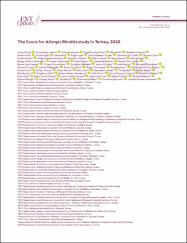The score for allergic rhinitis study in Turkey, 2020

Göster/
Erişim
info:eu-repo/semantics/openAccessTarih
2021Yazar
Cingi, CemalMuluk, Nuray Bayar
Susaman, Nihat
Küçükcan, Nagehan
Kar, Murat
Altıntaş, Mustafa
Altın, Fazilet
Eroğlu, Sinan
Kef, Kemal
İpçi, Kağan
Güven, Selis Gülseven
Dizdar, Senem Kurt
Çayır, Serkan
Salcan, İsmail
Korkmaz, Müge Özçelik
Yılmaz, Aslı Şahin
Topuz, Bülent
Başak, Sema
Ural, Ahmet
Çobanoğlu, Bengü Yaldız
Erkan, Alper Nabi
Oğhan, Fatih
Eskiizmir, Görkem
Çakır, Burak Ömür
Coşkun, Berna Uslu
Kara, Cüneyt Özgür
Gültekin, Erdoğan
Üçüncü, Harun
Selçuk, Adin
Altuntaş, Emine Elif
Durmuş, Kasım
Özlügedik, Samet
Toros, Sema Zer
Karameşe, Özgür
Bayındır, Tuba
Baylan, Müzeyyen Yıldırım
İynen, İsmail
Yılmaz, Orhan
Yılmaz, Nihat
Avcı, Deniz
Aysel, Abdulhalim
Bal, Cengiz
Başer, Serdar
Bozkurt, Ziya
Çatlı, Tolgahan
Çetinkaya, Erdem Atalay
Öner, Fatih
Coşkun, Zerrin Özergin
Dizdar, Denizhan
Ekşi, Erkan
Gümüşlü, Bekir Can
Kaplan, Aşkın Keskin
Kınar, Abdullah
Parıldar, Hülya
Resuli, Ali Sayed
Köroğlu, Erdem
Yazıcı, Demet
Kurt, Yücel
Dilber, Muhammet
Çukurova, İbrahim
Annesi-Maesano, Isabella
Üst veri
Tüm öğe kaydını gösterKünye
Cingi, C., Songu, M., Ural, A., Annesi-Maesano, I., Erdogmus, N., Bal, C., Kahya, V., Koc, E. A., Cakir, B. O., Selcuk, A., Ozlugedik, S., Onal, K., Midilli, R., Ecevit, C., Pinar, E., Akoglu, E., Okuyucu, S., & Erkan, A. N. (2011). The Score For Allergic Rhinitis study in Turkey. American journal of rhinology & allergy, 25(5), 333–337. https://doi.org/10.2500/ajra.2011.25.3665Özet
Objective: This study aimed to determine how prevalent allergic rhinitis (AR) is in Turkey and to compare the current prevalence with the figures obtained 10 years earlier.
Methods: This study included 9,017 participants. The minimum number of participants required from each center was determined via a stratified sampling technique according to regional demographic characteristics as ascertained from the last census. For each region, both men and women were administered the score for allergic rhinitis (SFAR) questionnaire and a score for each participant was calculated based on the responses supplied.
Results: A total of 9,017 individuals (55.3% men and 44.7% women) took part in this study. Of these, 94.4% were urban residents and 5.6% lived in a rural setting. Of the men, 38.5% self-reported as suffering from AR. The corresponding figure in women was 40.5%. The overall prevalence of AR, as deduced on the basis of the SFAR, was found to be 36.7%. Comparing the prevalence in different regions, we found that AR was the least prevalent in the Black Sea region with a frequency of 35.8%. The highest prevalence was in the Mediterranean region, where the prevalence was 37.7%. There was no statistical significance in the apparent differences in prevalence between different geographical regions. Despite this, however, there was a clear increase in the frequency of AR over the preceding decade. This increase was most pronounced in the South-Eastern Anatolian region, where the frequency rose from 21.0% to 36.9%.
Conclusion: Our results indicate that there has been a marked increase in the prevalence of AR in every region in Turkey over the last 10 years. This could be related to living conditions in urban environments. Alterations in lifestyle, urban living, air pollution causing impairments in immune defense mechanisms, and other aspects of modern lifestyles may account for the increase in AR in Turkey.

















